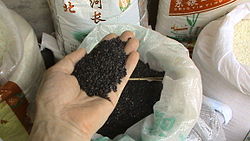


Black rice, also known as purple rice or forbidden rice, is a range of rice types of the species Oryza sativa, some of which are glutinous rice.
There are several varieties of black rice available today. These include Indonesian black rice, Philippine heirloom balatinaw black rice and pirurutong black glutinous rice, and Thai jasmine black rice.[1] It is also known as chak-hao in Manipur, India and as "kavuni arisi" or "kavuni rice" in Tamil Nadu, India.
The bran hull (outermost layer) of black rice contains one of the highest levels of anthocyanin pigment found in food.[2] The grain has a similar amount of fiber to brown rice and like brown rice, has a mild, nutty taste.[3]
Black rice has a deep black color and usually turns deep purple when cooked. Its dark purple color is primarily due to its anthocyanin content,[4] which is higher by weight than that of other colored grains.[5] It is suitable for creating porridge, dessert, traditional Chinese black rice cake, bread, and noodles.
| Name | Amount | Unit |
|---|---|---|
| Energy | 356 | kcal |
| Protein | 8.89 | g |
| Total lipid (fat) | 3.33 | g |
| Carbohydrate, by difference | 75.56 | g |
| Fiber, total dietary | 2.2 | g |
| Sugars, total including NLEA | 0 | g |
| Calcium, Ca | 0 | mg |
| Iron, Fe | 2.4 | mg |
| Sodium, Na | 0 | mg |
| Vitamin C, total ascorbic acid | 0 | mg |
| Vitamin A, IU | 0 | IU |
| Fatty acids, total saturated | 0 | g |
| Fatty acids, total trans | 0 | g |
| Cholesterol | 0 | mg |
History
[edit]In marketing, black rice may be called "forbidden rice", based on claims that it was once reserved for Chinese royalty.[8][4] Its rarity, nutritional value, and low yield may have contributed to its association with privilege and imperial use in ancient China.[8]
The blackness trait occurred from alteration of a gene called Kala4, which activates the production of anthocyanin pigments.[4] The black tropical japonica gene may have spread into rice subspecies via natural transfer of genes through multiple crosses and by purposeful cultivation for the black trait.[4]
See also
[edit]References
[edit]- ^ "Heirloom rice preserved, made productive". Philippine Rice Research Institute. Department of Agriculture, Philippines. 2017-02-20. Retrieved 29 June 2018.
- ^ Yao, S. L.; Xu, Y; Zhang, Y. Y.; Lu, Y. H. (2013). "Black rice and anthocyanins induce inhibition of cholesterol absorption in vitro". Food & Function. 4 (11): 1602–8. doi:10.1039/c3fo60196j. PMID 24056583.
- ^ "Food Grains of India". Bulletin of Miscellaneous Information (Royal Botanic Gardens, Kew). 232-234. 1892 (70): 234. 1892. doi:10.2307/4102547. JSTOR 4102547.
- ^ a b c d Oikawa T, Maeda H, Oguchi T, et al. (September 2015). "The Birth of a Black Rice Gene and Its Local Spread by Introgression". The Plant Cell. 27 (9): 2401–14. doi:10.1105/tpc.15.00310. PMC 4815089. PMID 26362607.
- ^ Abdel-Aal, El-Sayed M; Young, J. Christopher; Rabalski, Iwona (2006). "Anthocyanin composition in black, blue, pink, purple, and red cereal grains". Journal of Agricultural and Food Chemistry. 54 (13): 4696–704. doi:10.1021/jf0606609. PMID 16787017.
- ^ Saikia, Partha. "Black Rice-Nutrition, Recipe & Benefits (Manipuri Black Rice)". North East India info. Archived from the original on 2020-06-25. Retrieved 2020-06-25.
- ^ "FoodData Central". fdc.nal.usda.gov. Retrieved 2020-06-25.
- ^ a b "The origins of black rice". Asian Scientist. 30 September 2015. Retrieved 25 July 2025.
